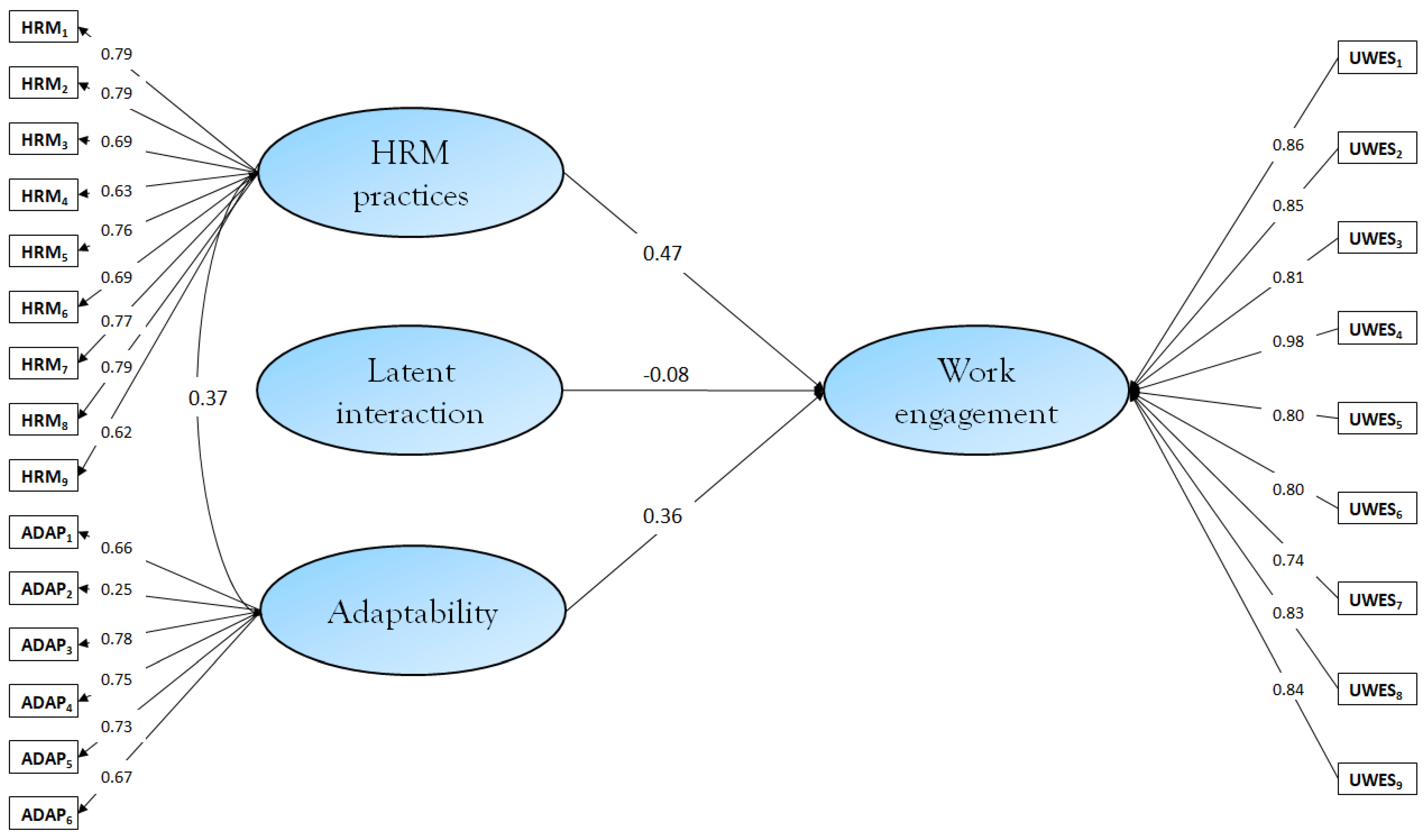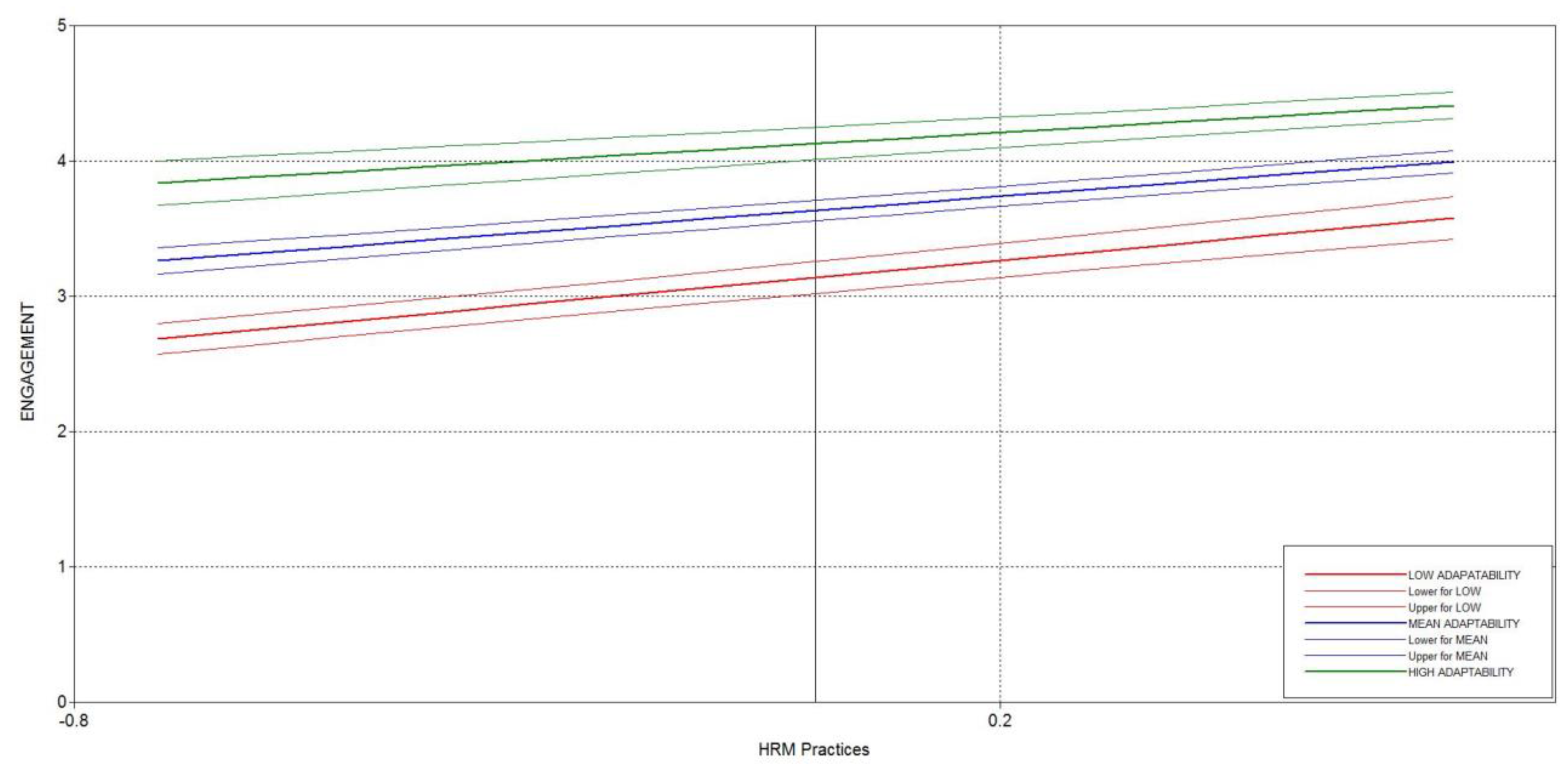HRM Practices and Work Engagement Relationship: Differences Concerning Individual Adaptability
Abstract
:1. Introduction
1.1. HRM Practices as an Antecedent of Work Engagement in Social Exchange Theory?
1.2. The Moderating Role of Adaptability
2. Materials and Methods
2.1. Sample
2.2. Measures
2.3. Statistical Analyses
3. Results
4. Discussion
4.1. Theoretical Implications
4.2. Practical Implications
4.3. Limitations and Future Research
5. Conclusions
Author Contributions
Funding
Informed Consent Statement
Data Availability Statement
Acknowledgments
Conflicts of Interest
References
- Van De Voorde, K.; Paauwe, J.; Van Veldhoven, M. Employee Well-being and the HRM–Organizational Performance Relationship: A Review of Quantitative Studies. Int. J. Manag. Rev. 2012, 4, 391–407. [Google Scholar] [CrossRef]
- Lesener, T.; Gusy, B.; Jochmann, A.; Wolter, C. The drivers of work engagement: A meta-analytic review of longitudinal evidence. Work Stress 2020, 34, 259–278. [Google Scholar] [CrossRef]
- Ahmed, U.; Abdul, H.A.M.; Lazim, M.Z. Moderating HR: Critical link between Developmental HR Practices and work engagement in a Moderated Model. Manag. Rev. Int. J. 2016, 11, 4–22. [Google Scholar] [CrossRef]
- Ahmed, U.; Kura, K.M.; Umrani, W.A.; Pahi, M.H. Modelling the Link between Developmental Human Resource Practices and Work Engagement: The Moderation Role of Service Climate. Glob. Bus. Rev. 2020, 21, 31–53. [Google Scholar] [CrossRef]
- Srivastava, U.R.; Mishra, M.K. Impact of High Performance HR Practices on Organizational Citizenship Behavior (OCB) and Turnover Intentions of Insurance Professionals. Psyber. News 2018, 9, 20–36. Available online: https://www.indianjournals.com/ijor.aspx?target=ijor:psn&volume=9&issue=1&article=002 (accessed on 15 June 2021).
- Khan, M.T.; Khan, N.A.; Ahmed, S. The Nature and Impact of Human Resource Management (HRM) Practices. Inter. J. Inf. Bus. Manag. 2013, 5, 123–138. Available online: http://ijibm.site666.com/IJIBM_Vol5No1_Feb2013.pdf#page=124 (accessed on 25 July 2021).
- Gould-Williams, J.; Davies, F. Using social exchange theory to predict the effects of hrm practice on employee outcomes: An analysis of public sector workers. Pub. Manag. Rev. 2005, 7, 1–24. [Google Scholar] [CrossRef]
- Bakker, A.B.; Albrecht, S. Work engagement: Current trends. Car. Dev. Int. 2018, 23, 4–11. [Google Scholar] [CrossRef]
- Alfes, K.; Shantz, A.D.; Truss, C.; Soane, C.E. The link between perceived human resource management practices, engagement and employee behaviour: A moderated mediation model. Int. J. Hum. Resour. Manag. 2013, 24, 330–351. [Google Scholar] [CrossRef] [Green Version]
- Rich, B.L.; LePine, J.A.; Crawford, E.R. Job Engagement: Antecedents and Effects on Job Performance. Acad. Manag. J. 2010, 53, 617–635. [Google Scholar] [CrossRef]
- Albrecht, S.L.; Bakker, A.B.; Gruman, J.A.; Macey, W.H.; Saks, A.M. Employee engagement, human resource management practices and competitive advantage: An integrated approach. J. Org. Eff. People Perform. 2015, 2, 7–35. [Google Scholar] [CrossRef] [Green Version]
- Muduli, A.; Verma, S.; Datta, S.K. High Performance Work System in India: Examining the Role of Employee Engagement. J. Asia-Pac. 2016, 17, 130–150. [Google Scholar] [CrossRef]
- Turner, P. Engagement Driven Strategic HRM. In Employee Engagement in Contemporary Organizations, 1st ed.; Turner, P., Ed.; Palgrave Macmillan: London, UK, 2020; pp. 223–256. [Google Scholar]
- Ployhart, R.E.; Bliese, P.D. Individual Adaptability (I-ADAPT) Theory: Conceptualizing the Antecedents, Consequences, and Measurement of Individual Differences in Adaptability. In Understanding Adaptability: A Prerequisite for Effective Performance within Complex Environments, 2nd ed.; Shawn Burke, C., Pierce, L.G., Salas, E., Eds.; Emerald Group Publishing Limited: Bingley, UK, 2006; Volume 6, pp. 3–39. [Google Scholar]
- Blau, P.M. A Theory of Social Integration. Am. J. Soc. 1960, 65, 545–556. [Google Scholar] [CrossRef]
- Schaufeli, W.B.; Salanova, M.; González-Romá, V.; Bakker, A.B. The measurement of engagement and burnout: A confirmative analytic approach. J. Happiness Stud. 2002, 3, 71–92. [Google Scholar] [CrossRef]
- Bakker, A.B. Building engagement in the workplace. In The Peak Performing Organization, 1st ed.; Burke, R.J., Cooper, C.L., Eds.; Routledge: Oxon, UK, 2009; pp. 50–72. [Google Scholar]
- Van Allen, S. Engagement at Work: Its Effects on Performance Continues in Tough Economic Times. Available online: https://www.gallup.com/services/176657/engagement-work-effect-performance-continues-tough-economic-times.aspx (accessed on 25 July 2021).
- Van Tuin, L.; Schaufeli, W.B.; Van Den Broeck, A. Engaging leadership: Enhancing work engagement through intrinsic values and need satisfaction. Hum. Resour. Dev. Q. 2021, 1, 1–23. [Google Scholar] [CrossRef]
- Aybas, M.; Acar, A.C. The Effect of Human Resource Management Practices on Employees’ Work Engagement and the Mediating and Moderating. Int. Rev. Manag. Mark. 2017, 7, 363–372. Available online: https://www.econjournals.com/index.php/irmm/article/view/3534 (accessed on 25 July 2021).
- Bal, P.M.; Kooij, D.T.; De Jong, S.B. How Do Developmental and Accommodative HRM Enhance Employee Engagement and Commitment? The Role of Psychological Contract and SOC Strategies. J. Manag. Stud. 2013, 50, 545–572. [Google Scholar] [CrossRef] [Green Version]
- Cropanzano, R.; Mitchell, M.S. Social Exchange Theory: An Interdisciplinary Review. J. Manag. 2005, 31, 874–900. [Google Scholar] [CrossRef] [Green Version]
- Wright, P.M.; Boswell, W.R. Desegregating HRM: A review and synthesis of micro and macro Human Resource Management Research. J. Manag. 2002, 28, 247–276. [Google Scholar] [CrossRef]
- Bowen, D.E.; Ostroff, C. Understanding HRM–Firm Performance Linkages: The Role of the “Strength” of the HRM System. Acad. Manag. Rev. 2004, 29, 203–221. [Google Scholar] [CrossRef] [Green Version]
- Kinnie, N.; Hutchinson, S.; Purcell, J.; Rayton, B.; Swart, J. Satisfaction with HR practices and commitment to the organisation: Why one size does not fit all. Hum. Resour. Manag. J. 2005, 15, 9–29. [Google Scholar] [CrossRef] [Green Version]
- Saks, A.M. Antecedents and consequences of employee engagement. J. Manag. Psychol. 2006, 21, 600–619. [Google Scholar] [CrossRef] [Green Version]
- Parent, J.D.; Lovelace, K.J. Employee engagement, positive organizational culture and individual adaptability. Horizon 2018, 26, 206–214. [Google Scholar] [CrossRef]
- Balducci, C.; Fraccaroli, F.; Schaufeli, W.B. Psychometric properties of the Italian version of the Utrecht Work Engagement Scale (UWES-9). Eur. J. Psychol. Assess. 2010, 26, 143–149. [Google Scholar] [CrossRef] [Green Version]
- Schaufeli, W.B.; Bakker, A.B.; Salanova, M. The measurement of work engagement with a short questionnaire: A cross-national study. Educ. Psychol. Meas. 2006, 66, 701–716. [Google Scholar] [CrossRef]
- Muthén, L.K.; Muthén, B.O. Mplus User’s Guide, 8th ed.; Muthén & Muthén: Los Angeles, CA, USA, 2017; pp. 43–515. [Google Scholar]
- Klein, A.G.; Moosbrugger, H. Maximum likelihood estimation of latent interaction effects with the LMS method. Psychometrika 2000, 65, 457–474. [Google Scholar] [CrossRef]
- Barbaranelli, C.; Ghezzi, V.; Di Tecco, C.; Ronchetti, M.; Fida, R.; Ghelli, M.; Persechino, B.; Iavicoli, S. Assessing Objective and Verifiable Indicators Associated with Work-Related Stress: Validation of a Structured Checklist for the Assessment and Management of Work-Related Stress. Front. Psychol. 2018, 9, 25–41. [Google Scholar] [CrossRef] [PubMed]
- Kline, A.G. Principles and Practice of Structural Equation Modeling, 4th ed.; The Guilford Press: New York, NY, USA, 2016; pp. 164–210. [Google Scholar]
- Manuti, A.; Giancaspro, M.L. People Make the Difference: An Explorative Study on the Relationship between Organizational Practices, Employees’ Resources, and Organizational Behavior Enhancing the Psychology of Sustainability and Sustainable Development. Sustainability 2019, 11, 1499. [Google Scholar] [CrossRef] [Green Version]
- Conway, E.; Fu, N.; Monks, K.; Alfes, K.; Bailey, C. Demands or Resources? The Relationship between HR Practices, Employee Engagement, and Emotional Exhaustion Within a Hybrid Model of Employment Relations. Hum. Resour. Manag. 2016, 55, 2–17. [Google Scholar] [CrossRef]
- Bailey, C.; Madden, A.; Alfes, K.; Fletcher, L.; Robinson, D.; Holmes, J.; Buzzeo, J.; Currie, G. Evaluating the evidence on employee engagement and its potential benefits to NHS staff: A narrative synthesis of the literature. Health Serv. Res. 2015, 3, 1–424. [Google Scholar] [CrossRef] [Green Version]
- Cascio, W.F. Changes in workers, work, and organizations. In Handbook of Psychology: Industrial and Organizational Psychology; Borman, W.C., Ilgen, D.R., Klimoski, R.J., Eds.; Wiley: Hoboken, NJ, USA, 2003; Volume 12, pp. 401–422. [Google Scholar]
- Ilgen, D.R.; Pulakos, E.D. Employee Performance in Today’s organizations. In The Changing Nature of Performance: Implications for Staffing, Motivation, and Development. Frontiers of Industrial and Organizational Psychology; Ilgen, D.R., Pulakos, E.D., Elaine, D., Eds.; Jossey-Bass: San Francisco, CA, USA, 1999; pp. 1–18. [Google Scholar]
- Veth, K.N.; Korzilius, H.P.L.M.; Van der Heijden, B.I.J.M.; Emans, B.J.M.; De Lange, A.H. Which HRM practices enhance employee outcomes at work across the life-span? Int. J. Hum. Resour. Manag. 2019, 30, 2777–2808. [Google Scholar] [CrossRef] [Green Version]
- Jenkins, S.; Delbridge, R. Context matters: Examining ‘soft’ and ‘hard’ approaches to employee engagement in two workplaces. Int. J. Hum. Resour. Manag. 2013, 24, 2670–2691. [Google Scholar] [CrossRef]
- Podsakoff, P.M.; MacKenzie, S.B.; Lee, J.Y. Common Method Biases in behavioral research: A critical review of the literature and recommended remedies. J. Appl. Psychol. 2003, 88, 879–903. [Google Scholar] [CrossRef]


| Gender | 45.7% Women; 54.3% Men |
|---|---|
| Organizational sector | 33.0% Public sector |
| 64.26% Private sector | |
| 2.8% Non-profit sector | |
| Organizational size | 28.6% < 10 employees |
| 20.3% between 10 and 50 employees | |
| 18.7% between 50 and 250 employees | |
| 32.3% > 250 employees | |
| Contract type | 62.1% Permanents |
| 24.4% Temporaries | |
| 13.5% Other contract type | |
| Education | 5.9% Elementary license |
| 50.6% High school diploma | |
| 32.8% Graduated | |
| 10.7% Postgraduate degree |
| Mean | Standard Deviation | Asymmetry | Kurtosis | 1 | 2 | 3 | |
|---|---|---|---|---|---|---|---|
| 1. HRM practices | 4.96 | 1.27 | −0.03 | −0.72 | 1 | 0.43 ** | 0.62 ** |
| 2. Adaptability | 3.52 | 0.78 | −0.53 | 0.26 | 1 | 0.48 ** | |
| 3. Engagement | 3.65 | 1.02 | −0.56 | −0.48 | 1 |
Publisher’s Note: MDPI stays neutral with regard to jurisdictional claims in published maps and institutional affiliations. |
© 2021 by the authors. Licensee MDPI, Basel, Switzerland. This article is an open access article distributed under the terms and conditions of the Creative Commons Attribution (CC BY) license (https://creativecommons.org/licenses/by/4.0/).
Share and Cite
Urbini, F.; Chirumbolo, A.; Giorgi, G.; Caracuzzo, E.; Callea, A. HRM Practices and Work Engagement Relationship: Differences Concerning Individual Adaptability. Sustainability 2021, 13, 10666. https://doi.org/10.3390/su131910666
Urbini F, Chirumbolo A, Giorgi G, Caracuzzo E, Callea A. HRM Practices and Work Engagement Relationship: Differences Concerning Individual Adaptability. Sustainability. 2021; 13(19):10666. https://doi.org/10.3390/su131910666
Chicago/Turabian StyleUrbini, Flavio, Antonio Chirumbolo, Gabriele Giorgi, Emanuela Caracuzzo, and Antonino Callea. 2021. "HRM Practices and Work Engagement Relationship: Differences Concerning Individual Adaptability" Sustainability 13, no. 19: 10666. https://doi.org/10.3390/su131910666
APA StyleUrbini, F., Chirumbolo, A., Giorgi, G., Caracuzzo, E., & Callea, A. (2021). HRM Practices and Work Engagement Relationship: Differences Concerning Individual Adaptability. Sustainability, 13(19), 10666. https://doi.org/10.3390/su131910666









